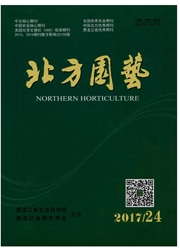

 中文摘要:
中文摘要:
以2年生北高丛越橘(Vaccinium corymbosum L.)‘蓝丰’、‘公爵’和‘布里吉他’为试验材料,利用人工气候箱设置4个培养温度(25、30、35和40℃),研究高温对叶片叶绿体超显微结构、气体交换参数、叶绿素荧光、抗氧化酶活性、色素含量以及电导率的影响。结果表明:温度对3个品种超氧化物歧化酶(SOD)活性影响不大,但显著改变了3个品种叶片的过氧化物酶(POD)、过氧化氢酶(CAT)活性。40℃对‘公爵’和‘蓝丰’的叶绿体结构有不同程度的破坏,而对‘布里吉他’没有产生显著影响。另外,随着温度的升高,3个品种叶片的叶绿素a(Chl.a)、叶绿素b(Chl.b)、叶绿素a/叶绿素b(Chl.a/b)、总叶绿素[Chl.(a+b)]及类胡萝卜素(Car.)均呈现先升高后降低的趋势,且3个品种的净光合速率(P_n)、蒸腾速率(T_r)和水分利用效率(WUE)也出现了相似的变化趋势,品种不同其最大值出现的温度也不同。叶片相对电导率和叶绿素荧光参数F_v/F_m的测定结果也间接地支持了上述结论,即30℃和35℃高温对叶片结构和功能的影响有限,但40℃高温导致其受到严重损伤。抗高温能力‘布里吉他’最强,‘蓝丰’次之,‘公爵’最弱。
 英文摘要:
英文摘要:
The effects of high temperatures on leaf traits,chloroplast ultra-structures,gas exchange,chlorophyll fluorescence parameters,antioxidant enzyme activity,pigment contents,and electrolyte leakage of three north highbush blueberry cultivars(‘Bluecrop',‘Duke'and‘Brigitta')were examined with four growth chambers by controlling growth temperatures at 25,30,35 and 40 ℃. The results showed that temperature barely changed the activity of superoxide dismutase(SOD)of the three cultivars,but significantly affected the activity of peroxidase(POD)and catalase(CAT). Meanwhile,the chloroplast ultrastructure was seriously damaged at the growing temperature of 40 ℃ except for‘Brigitta'. Moreover,both the chlorophyll and carotenoid pigments of the three north highbush blueberry cultivars were decreased with the increase of temperature. The net photosynthetic rates(P_n),transpiration rates(T_r),and water use efficiency(WUE)also featured a similar trend. Moreover,the measurements on the electrolyte leakage and F_v/F_m indirectly supported the above conclusions and suggested that 30 ℃ and 35 ℃ had little effects on the leaf structure and function of the three blueberry cultivars,but 40 ℃ resulted in severe damages on the cellular membrane structure. These results suggested that three north highbush blueberry cultivars had different ability in resisting heat stress with ‘Brigitta'〉‘Bluecrop'〉‘Duke'.
 同期刊论文项目
同期刊论文项目
 同项目期刊论文
同项目期刊论文
 期刊信息
期刊信息
